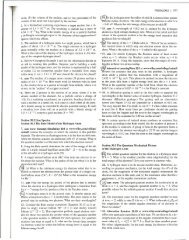Solutions to Homework problems Chapters 29. Including a
Solutions to Homework problems Chapters 29. Including a
Solutions to Homework problems Chapters 29. Including a
You also want an ePaper? Increase the reach of your titles
YUMPU automatically turns print PDFs into web optimized ePapers that Google loves.
1492 PARTICLES AND WAVES<br />
Using values for melectron and mpro<strong>to</strong>n taken from the inside of the front cover, we find that<br />
the speed of the pro<strong>to</strong>n is<br />
pro<strong>to</strong>n - velectron m =. x m/s -27 = 2.45xlO m/S<br />
v - [melectron: pro<strong>to</strong>n (450 106 )(9.11X10-31 1.67 X 10 kg] kg I 3 I<br />
25. REASONING AND SOLUTION The momentum of the pho<strong>to</strong>n is p = h/A and that of the<br />
electron is p = mv. Equating and solving for the wavelength of the pho<strong>to</strong>n,<br />
26. REASONING The de Broglie wavelength A is related <strong>to</strong> Planck's constant h and the<br />
magnitude p of the particle's momentum. The magnitude of the momentum can be related<br />
<strong>to</strong> the particle's kinetic energy. Thus, using the given wavelength and the fact that the<br />
kinetic energy doubles, we will be able <strong>to</strong> obtain the new wavelength.<br />
SOLUTION The de Broglie wavelength is<br />
The kinetic energy and the magnitude of the momentum are<br />
1 2<br />
KE = - mv<br />
2<br />
(6.2)<br />
p=mv<br />
or<br />
(7.2)<br />
(<strong>29.</strong>8)<br />
where m and v are the mass and speed of the particle. Substituting Equation 7.2 in<strong>to</strong><br />
Equation 6.2, we can relate the kinetic energy and momentum as follows:<br />
Substituting this result for p in<strong>to</strong> Equation <strong>29.</strong>8 gives<br />
h h<br />
A = p = ~2m(KE)



